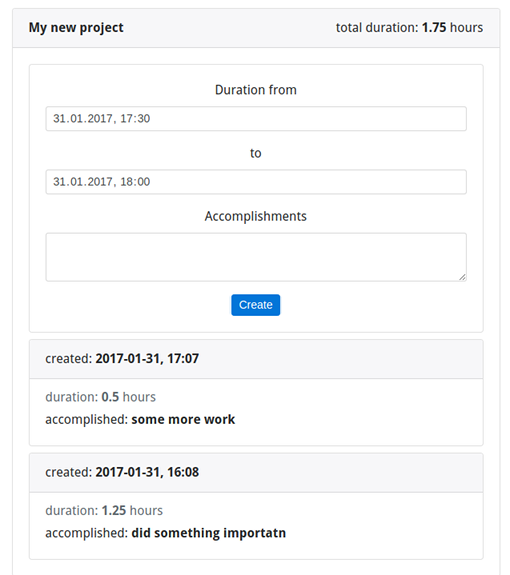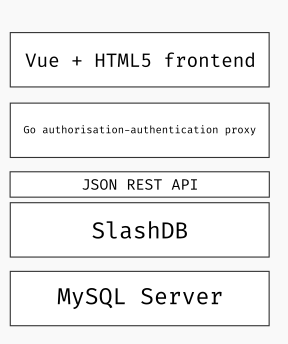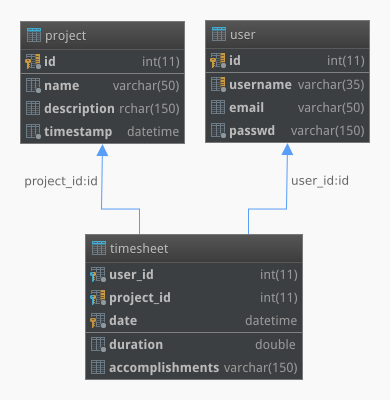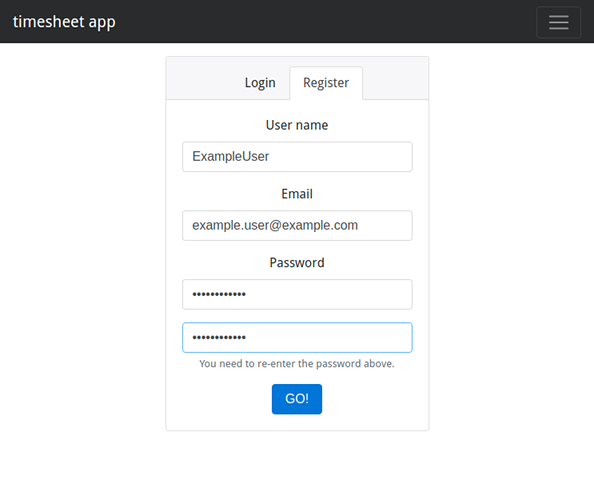We will be building a simple poof of concept, time tracking app and basing it on a SlashDB powered API. The app itself will allow users to register, login/logout, add new projects, add tasks to those projects and it will automatically sum-up the time a given project has taken. Here's a little preview of the frontend:
SlashDB can automatically generates a REST API from relational databases making it easy to access and modify our data. In general, it will save a lot of work coding my own data API-s.
Go (Golang for search engines) is a language by Google, often used as a (micro)service building tool. It has (most) batteries included, allowing us to build a simple authentication layer between our data and the frontend. It's also a compiled language i.e. we can build statically linked binaries for easy distribution and even embed our assets (CSS, JS etc) into that binary.
After my experience with Angular 1.x (and a bit of React), I choose Vue - a small and simple front-end js framework. It's somewhere between those two frameworks (but a lot closer to React) and only focuses on the V(iew) part of MVC. Similar to Angular, we have things like template directives (i.e. ng-for="item in items" -> v-for="item in items") - so no cumbersome JSX transpilation (a big plus - at least for me). And similar to React, we get one-way data flow i.e. always parent -> child node communication (so harder to achieve the level of Angular app craziness). In general it's easier to understand what our app is doing at a given time, also we get the awesome dev tools :)
What the developer needs to implement is, the frontend GUI and a way to do authentication/authorization for the user. The RESTful API part is provided to us for free by SlashDB.
Important: This part requires you to understand the basic of SQL and DB server setup (if you choose to use something other thant SQLite).
For development purposes, SlashDB is available for free use and I recommend using the docker image for an fast way to get started.
$ docker pull slashdb/slashdb
$ mkdir timesheet-docker
$ cd timesheet-docker
$ wget -c https://downloads.slashdb.com/latest/default-slashdb-configs.zip
$ unzip default-slashdb-configs.zip
$ docker run -d -p 8000:80 -v $PWD/slashdb:/etc/slashdb -v $PWD/slashdb:/var/log/slashdb slashdb/slashdb
Go to http://localhost:8000/ and follow the initial developer setup wizard.
Now we need to create a database, in this example I'll be using MySQL, but any DB engine supported by SlashDB will do. Installing/configuring MySQL server is outside of scope of this article, so I'll just skip this part. For the timesheet app we'll need a database (preferably named timesheet), a user with read/write privileges, to said DB and 3 tables: project, user and timesheet.
DROP TABLE IF EXISTS timesheet;
DROP TABLE IF EXISTS project;
CREATE TABLE `project` (
`id` int(11) NOT NULL AUTO_INCREMENT,
`name` varchar(50) NOT NULL,
`description` varchar(150) DEFAULT NULL,
`timestamp` datetime NOT NULL DEFAULT CURRENT_TIMESTAMP,
PRIMARY KEY (`id`),
UNIQUE KEY `project_id_uindex` (`id`)
) ENGINE=InnoDB DEFAULT CHARSET=utf8;
DROP TABLE IF EXISTS user;
CREATE TABLE `user` (
`id` int(11) NOT NULL AUTO_INCREMENT,
`username` varchar(35) NOT NULL,
`email` varchar(50) DEFAULT NULL,
`passwd` varchar(150) NOT NULL,
PRIMARY KEY (`id`),
UNIQUE KEY `user_id_uindex` (`id`),
UNIQUE KEY `user_username_uindex` (`username`)
) ENGINE=InnoDB DEFAULT CHARSET=utf8;
CREATE TABLE `timesheet` (
`user_id` int(11) NOT NULL,
`project_id` int(11) NOT NULL,
`date` datetime NOT NULL DEFAULT CURRENT_TIMESTAMP,
`duration` double NOT NULL,
`accomplishments` varchar(150) DEFAULT NULL,
PRIMARY KEY (`user_id`,`project_id`,`date`),
FOREIGN KEY (`user_id`) REFERENCES `user` (`id`),
FOREIGN KEY (`project_id`) REFERENCES `project` (`id`)
) ENGINE=InnoDB DEFAULT CHARSET=utf8;This is MySQL-s SQL dialect, but it gives a general idea about the table layout and is easy enough to adjust for other SQL dialects. This code is available as the file content of timesheet.sql in the repository. Running it on your MySQL server will also provide you with some basic data (app user: slashdb and password: slashdb).
And if you prefer a diagram, heres one:
After we have our DB, tables and user setup we need to make SlashDB aware of it. Going to http://localhost:8000/ and logging-in as the admin, we can config and add our database endpoint, for simplicity, I named the endpoint timesheet. In this case, I also enabled the Auto Discover feature and provided credentials for my MySQL user. Save and remembering to make sure the DB has connected without errors (green Connected status) and we're set.
It's a good idea to create a new user for remote access to our resources, so following the docs, I'll add a user named - you guessed it - timesheet. Also as our proxy authorization/authentication app will connect to SlashDB directly it's a good to set an API key for that user - in this example: timesheet-api-key. Finally, add our newly created data source to this users Database Mappings and Save. We need to log-in as the timesheet user, and check if we have access to our tables. The project endpoint, should now display an empty table - but (hopefully) no errors.
Thats it - now you have your data provided as an RESTful API, curtesy of SlashDB :)
Important: This part requires you to understand some basics of programming in Go, its setup (i.e. [$GOPATH/$GOROOT(https://github.com/golang/go/wiki/GOPATH)]) and it's basic tooling (i.e. go get/build/install). Form more reference on that visit Go-s wiki page.
The basic idea is to proxy all the request from the frontend to the SlashDB RESTful API and on the fly, do some resource authorization. Also we need to provide a way to create and authenticate timesheet app users.
In my setup, this app will have 4 endpoints.
/ - the SlashDB proxy
/app/ - the frontend app itself
/app/reg/ - user registration provider
/app/login/ - user login/token provider
In the spirit of keeping it simple, as a method of of providing a kind of stateless session, we'll use JWT. The /app/login/ endpoint will check user credentials and if everything's OK, provide a JWT token.
First, things first lets install everything we'll need:
$ go get golang.org/x/crypto/pbkdf2
$ go get github.com/dgrijalva/jwt-go/...
$ go get github.com/jteeuwen/go-bindata/...
$ go get github.com/elazarl/go-bindata-assetfs/...
Tip: you can just run the build.sh script to install all requirements and compile the app
Using GoLangs builtin httputil.ReverseProxy, we create a lightweight reverse proxy:
// for the full code, view auth.go source file
func setupProxy() {
// get address for the SlashDB instance and parse the URL
url, err := url.Parse(pa.SdbInstanceAddr)
if err != nil {
log.Fatalln(err)
}
// create a reverse proxy
proxy := httputil.NewSingleHostReverseProxy(url)
// make it play nice with https endpoints
proxy.Transport = &http.Transport{
TLSClientConfig: &tls.Config{InsecureSkipVerify: true},
}
proxyHandler := func(w http.ResponseWriter, r *http.Request) {
// set API key for easy proxy-to-SDB communication
q := r.URL.Query()
q.Set(pa.ParsedSdbAPIKey, pa.ParsedSdbAPIValue)
r.URL.RawQuery = q.Encode()
...
}
// bind the proxy handler to "/"
http.HandleFunc("/", authorizationMiddleware(proxyHandler))
}So now, when requesting something from the default localhost:8000 we'll get redirected to the root of the selected SlashDB instance i.e. requesting
http://localhost:8000/db/timesheet/project/project_id/1.json -> http://demo.slashdb.com/db/timesheet/project/project_id/1.json
and the response will be transparently returned to the us.
The authorizationMiddleware function applies all the authorization logic to the proxied requests i.e. it extracts the JWT token and checks if it's valid and depending on the user permissions, allows or prohibits resource access.
func authorizationMiddleware(fn func(http.ResponseWriter, *http.Request), secret []byte) func(w http.ResponseWriter, r *http.Request) {
return func(w http.ResponseWriter, r *http.Request) {
token, err := request.ParseFromRequest(r, request.OAuth2Extractor, func(token *jwt.Token) (interface{}, error) {
// we simply check the token claims, but this is a good place
// to parse the r.URL.Path or other request parameters
// and determine if a given user can access requested data
// i.e. check if user of ID = 8 can access /db/timesheet/timesheet/user_id/8/project.json etc.
mc := token.Claims.(jwt.MapClaims)
_, ok := mc["id"]
if !ok {
return nil, fmt.Errorf("token lacks 'id' claim")
}
_, ok = mc["username"]
if !ok {
return nil, fmt.Errorf("token lacks 'username' claim")
}
...
return secret, nil
})
if err != nil || !token.Valid {
http.Error(w, http.StatusText(http.StatusUnauthorized), http.StatusUnauthorized)
return
}
// else call the original handler function
fn(w, r)
}
}In my example it's only a simple function, but of course, depending on the use case, we can implement any kind of authentication logic there.
The frontend app is being served from a static template and the rest is generated and managed by the Vue app.
afs := &assetfs.AssetFS{Asset: Asset, AssetDir: AssetDir, AssetInfo: AssetInfo, Prefix: ""}
http.HandleFunc("/app/", func(w http.ResponseWriter, r *http.Request) {
indexTmpl := template.New("index.html")
data, err := afs.Asset("index.html")
...
_, err = indexTmpl.Parse(string(data))
...
indexTmpl.Execute(w, pa)
})This little Go app also servers our static content
afs := &assetfs.AssetFS{Asset: Asset, AssetDir: AssetDir, AssetInfo: AssetInfo, Prefix: ""}
...
fs := http.FileServer(afs)
http.Handle("/app/static/", http.StripPrefix("/app/static/", fs))Tip: during development, a lot of changes will happen in the assets, so it would be nice not to have to rebuild the binary every time we change anything. It's good that go-bindata has a debug mode, running:
go-bindata -debug ./assets/... index.htmlwill generate a bindata.go file, but mock assets with function calls that load files form the HDD, when done debugging, just run ./build.sh
Before we can login we need a user, and for that we need to implement a way to register one. We also need to generate a password hash, store user info in the DB - so once again, SlashDB comes in handy here.
...
encodedPass := genPassword(un+passwd, nil)
payload := map[string]string{
"username": un,
"passwd": encodedPass,
"email": email,
}
data, err := json.Marshal(payload)
...
// by default:
// pa.SdbInstanceAddr = "https://demo.slashdb.com"
// pa.SdbDBName = "timesheet"
// pa.ParsedSdbAPIKey = "apikey"
// pa.ParsedSdbAPIValue = "timesheet-api-key"
req, _ = http.NewRequest("POST", pa.SdbInstanceAddr+"/db/"+pa.SdbDBName+"/user.json?"+pa.ParsedSdbAPIKey+"="+pa.ParsedSdbAPIValue, bytes.NewReader(data))
ureq, err := defaultClient.Do(req)
...
if ureq.StatusCode != http.StatusCreated {
// something went wrong, provide some useful response to the user or just return what SlashDB has returned
}
w.WriteHeader(http.StatusCreated)
w.Write([]byte(fmt.Sprintf("User %q was created successfully!", un)))Here we simply make a POST request to SlashDB-s /db/timesheet/user.json providing necessary info - no SQL required and if everything goes OK, well get a 201 (Created) status code and the URL of the new resource i.e. "/db/timesheet/users/user_id/10".
This little apps 'session' relies on the JWT token, so we need to authorize the user, generate that token and send it back to the user. This is done via loginHandler function and the token itself is generated, based on the user input (received via form data or URL params), in the genJWTToken function.
var defaultSecret = []byte("timesheet app secret")
func genJWTToken(username string, id int, secret []byte) (string, error) {
token := jwt.NewWithClaims(jwt.SigningMethodHS512, jwt.MapClaims{
"username": username,
"id": id,
"exp": time.Now().Add(time.Hour * 24).Unix(),
})
if len(secret) == 0 {
secret = defaultSecret
}
return token.SignedString(defaultSecret)
}Then, if everything goes according to plan, we return the new token to the user.
tc := struct {
Token string `json:"accessToken"`
}{st}
td, err := json.Marshal(tc)
if err != nil {
log.Printf("data: %v, error: %v", tc, err)
http.Error(w, http.StatusText(http.StatusInternalServerError), http.StatusInternalServerError)
return
}
w.Write(td)On the frontend side, we set the Authorization header and store the token in localStorage for future use i.e.
storeAuthInfo: function (authInfo) {
// set authorization token for all the request done by the Vue app
Vue.http.headers.common['Authorization'] = 'Bearer ' + authInfo.accessToken;
this.authInfo = authInfo;
this.userId = authInfo.payload.id;
this.userName = authInfo.payload.username;
localStorage.setItem(this.lsAuthInfoKey, JSON.stringify(authInfo));
}Thanks to this we can make further requests, without explicitly managing this token by hand. For instate when requesting user data.
var userId = 'id taken form JWT token';
this.$http.get('http://localhost:8000/db/timesheet/user_id/' + userId + '.json'))
.then(function(resp) {
// do something on a successful response
}, function(errResp) {
// do something else on an error
});We just take care of handling responses/errors and don't bother with anything else. The same goes for POST, PUT and DELETE requests - it's all supported by the SlashDB generated REST API.
In the init() function in main.go file, using the GoLang building lib flag package, I've added some command line arguments to this small proxy app. They allow for easy customization without recompiling the app (i.e. after deploying the binary to somewhere or giving it to someone). Here's a fast overview of the available commands and their default values.
$ ./timesheet:
-net-interface string
network interface to serve on (default "localhost")
-port uint
local port to serve on (default 8000)
-sdb-address string
SlashDB instance address (default "https://demo.slashdb.com")
-sdb-apikey string
SlashDB user API key, key and value separated by single ':' (default "apikey:timesheet-api-key")
-sdb-dbname string
SlashDB DB name i.e. https://demo.slashdb.com/db/>>timesheet<< (default "timesheet")
Just run:
$ ./build.sh
and you'll end up with linux/max/win binaries - with all the assets bundled inside.
If you want to play around with the code, it's available here, and the pre-build binaries are here.




